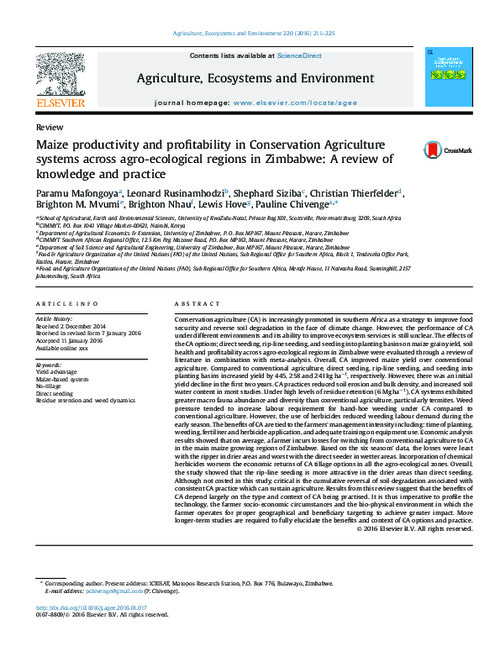Maize productivity and profitability in Conservation Agriculture systems across agro-ecological regions in Zimbabwe: A review of knowledge and practice
Abstract
Conservation agriculture (CA) is increasingly promoted in southern Africa as a strategy to improve food
security and reverse soil degradation in the face of climate change. However, the performance of CA
under different environments and its ability to improve ecosystem services is still unclear. The effects of
the CA options; direct seeding, rip-line seeding, and seeding into planting basins on maize grain yield, soil
health and profitability across agro-ecological regions in Zimbabwe were evaluated through a review of
literature in combination with meta-analysis. Overall, CA improved maize yield over conventional
agriculture. Compared to conventional agriculture, direct seeding, rip-line seeding, and seeding into
planting basins increased yield by 445, 258 and 241 kg ha 1, respectively. However, there was an initial
yield decline in the
first two years. CA practices reduced soil erosion and bulk density, and increased soil
water content in most studies. Under high levels of residue retention (6 Mg ha 1), CA systems exhibited
greater macro fauna abundance and diversity than conventional agriculture, particularly termites. Weed
pressure tended to increase labour requirement for hand-hoe weeding under CA compared to
conventional agriculture. However, the use of herbicides reduced weeding labour demand during the
early season. The benefits of CA are tied to the farmers’ management intensity including: time of planting,
weeding, fertiliser and herbicide application, and adequate training on equipment use. Economic analysis
results showed that on average, a farmer incurs losses for switching from conventional agriculture to CA
in the main maize growing regions of Zimbabwe. Based on the six seasons’ data, the losses were least
with the ripper in drier areas and worst with the direct seeder in wetter areas. Incorporation of chemical
herbicides worsens the economic returns of CA tillage options in all the agro-ecological zones. Overall,
the study showed that the rip-line seeding is more attractive in the drier areas than direct seeding.
Although not costed in this study, critical is the cumulative reversal of soil degradation associated with
consistent CA practice which can sustain agriculture. Results from this review suggest that the benefits of
CA depend largely on the type and context of CA being practised. It is thus imperative to profile the
technology, the farmer socio-economic circumstances and the bio-physical environment in which the
farmer operates for proper geographical and beneficiary targeting to achieve greater impact. More
longer-term studies are required to fully elucidate the benefits and context of CA options and practice

